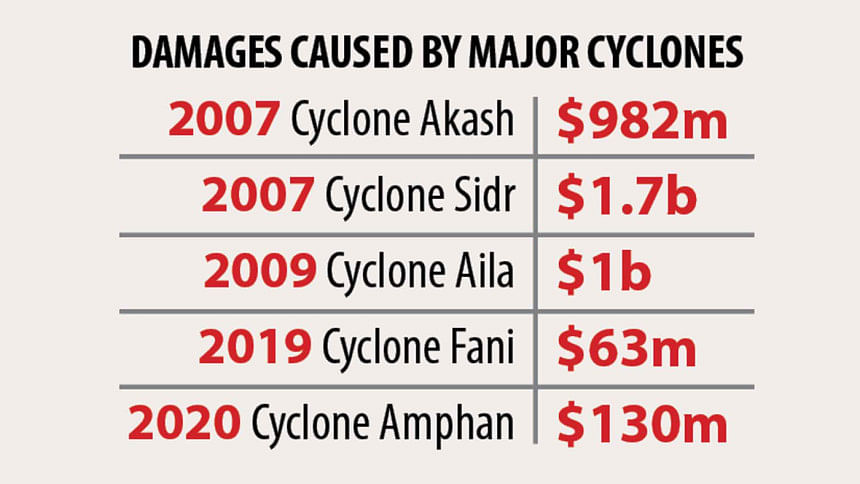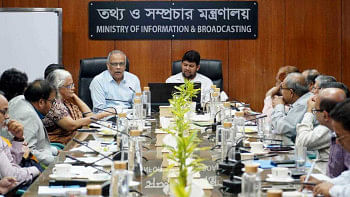Damaged By Cyclones, Tidal Surges: Fragile embankments put lives at risk

Against the backdrop of the country's coastal regions facing devastation from cyclones and tidal surges over decades, work of protecting people's lives and livelihoods through strong embankments and afforestation goes slow due to funding and policy constraints.
According to officials and water experts, a majority of some 5,700 kilometres of embankments in 19 coastal districts are not sufficient in preventing inundation by high tides, salinity intrusion and tidal surges from cyclonic storms.
This is because the embankments around the 139 polders (low-lying tract of land protected by embankments), constructed in the 1960s and 1970s, have been damaged in the recurring natural disasters in the coastal region, which is home to 35 million people -- 28 percent of the country's population.
The Water Development Board (WDB) at different times repaired the embankments but did not upgrade them in a way that proved sustainable.
Increasing height, using latest technologies including geo-bags and geo-tubes, afforestation, involving local people and local government in maintenance of the banks can greatly increase their longevity, experts said, fearing that the already-bad situation would worsen otherwise.
A World Bank study estimated 8 million people in the coastal region are vulnerable to inundation depths greater than three metres due to cyclonic storm surges. By 2050, this number may increase to 13.5 million, according to the study.
The risks loom large as the proportion of people living below the absolute poverty line is higher in the coastal regions, where salinity intrusion made vast areas of land uncultivable, while the calamities displaced hundreds of thousands of people.
Although fatalities declined from 5 lakh in 1970 and 1.4 lakh in 1991 to some 4,000 in the last two decades due to improved early warning systems and the presence of 12,000 cyclone shelters, the material damages of cyclones were enormous. The damages from five major cyclones between 2007 and 2020 totalled around $4 billion.
Only after the Cyclones Sidr in 2007 and Aila in 2009, the government obtained loans from the World Bank for the Coastal Embankment Improvement Project (CEIP) to improve over 400 kilometres of embankments of 10 polders in Bagerhat, Khulna, Satkhira, Barguna, Patuakhali and Pirojpur in the first phase.
"The project scheduled to begin in 2013 actually started in 2015. Its progress is about 65 percent now," Syed Hasan Imam, project director of CEIP, told this correspondent on April 18.
He said land acquisition, social and environmental impact assessments, resettlement issues took longer than usual, delaying the implementation. New technologies, including geo-bags and geo-tubes, are also being used in the embankments as required.
Besides, the Department of Forest is also planting trees on the banks to enhance sustainability. There are also local water associations to supervise the flushing and drainage sluices, he said.
He said the WDB repairs embankments on an individual case basis after damages or in cases where they become vulnerable, but the CEIP is the first mega project to strengthen the embankments with higher quality in terms of design and implementation.
After the first phase, the government is now discussing with development partners the second phase of CEIP to improve 20 other polders. Besides, the government has also proposed thatthe Public-Private Partnership Authority construct two super dykes -- one from Mirersharai of Chattogram to Cox's Bazar and the other along the coastal parts of Feni, Noakhali and Lakshmipur to protect the region from tidal surges. The construction of these super dykes will require Tk 67,000 crore.
"The polders and super dykes cannot stop the damage from the cyclones, but can reduce it to a great extent," Hasan Imam said. This will allow the farmers to do cultivation, which can significantly increase food production.
Water experts say all the 139 polders should be improved, including increasing heights depending on the projections of sea level rise and there should be a master plan and a clear funding mechanism.
Syed Aminul Hoque, director of COAST Foundation that works in the coastal region, said previous experiences suggest that bureaucratic red tape, irregularities in repairing embankments and purposeful destruction of those by shrimp farmers have left the polders in bad shape.
"What we need is strong and sustainable embankments and then their regular maintenance," said Brac University Professor Emeritus Dr Ainun Nishat.
Local communities and local government can be involved for maintaining embankments and in that case, how the local government can get the funds needs to be fixed, he said.
The WDB is good for constructing the embankments, but not in maintenance, the water expert added.
Ainun Nishat said the government is implementing the CEIP with loan from the World Bank, but as a climate victim, the country should get it as grants from sources like Green Climate Fund that should be annually $120 billion from 2020 as per the Paris Agreement.
"Delay in improving the embankment means we will face more catastrophes and rising cost of the work," he said.
He said land acquisition appears a challenge, but there are innovative ways to do that. For example, "You pay the compensation well ahead of beginning the project implementation. In that case, the people can resettle early."
Malik Fida A Khan, executive director at the Centre for Environmental and Geographic Information System (CEGIS), said the lack of funding is a crucial factor behind the slow progress in upgrading the embankments.
He also thinks all 139 polders need to be upgraded and it could require about $7 billion. However, he cautioned that it would be very important to undertake the upgrades with international standard designs, implement the project as per specifications and have it supervised by a third party.
Malik Fida, also member of National River Conservation Commission, suggested that afforestation along the embankments, keeping proper flushing and drainage sluices, regular dredging of the rivers and excavation of the canals within the polders are some tasks that need to be done diligently. Otherwise, there are risks of water logging in the polders that were observed in some cases in the past.
"If we can build strong embankments and maintain them, we can reduce the risks of climate change to a large extent in the coastal region," he said.

 For all latest news, follow The Daily Star's Google News channel.
For all latest news, follow The Daily Star's Google News channel. 



Comments